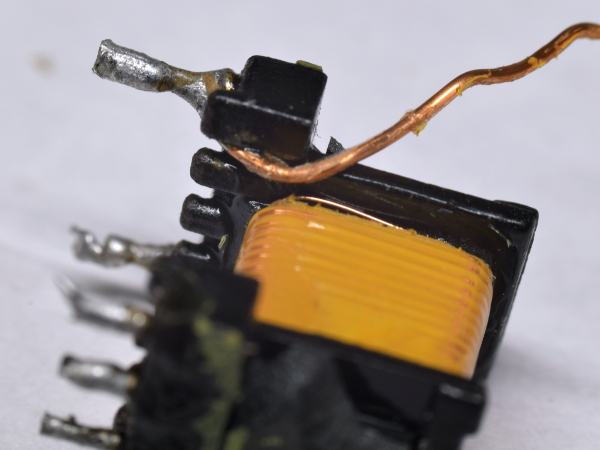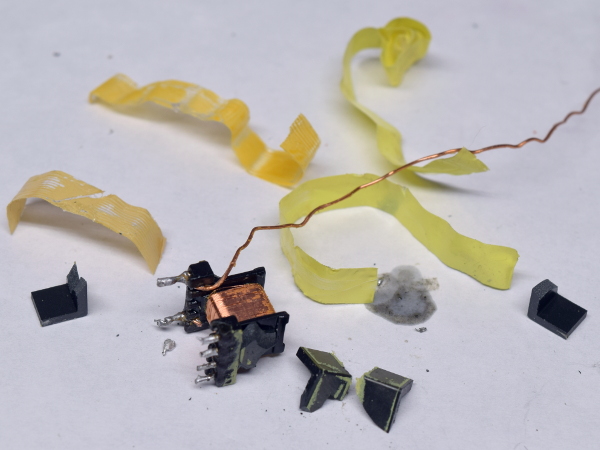Tom's Teardown: Two More Apple A1265 iPhone Charger Lookalikes
BDL1000 – Feeling Exposed
Here’s your problem: a single loose turn on the primary slipped outside the area covered by the insulation tape. Had it been taut against the transformer’s coil form, the transformer may have passed my 3500VAC test. Same thing if the secondary had been double-insulated for one whole turn at both ends, as it should have been, to cover small manufacturing mishaps like these.
These are fractional pennies standing between a safe transformer and a potential death trap.
MORE: Apple 5W Adapter Knock-offs: The Colorful A1265 Teardown
MORE: 10 Inexpensive Automotive USB Adapters, Tested
BDL1000 – Rest In Pieces
This makes two cheap generic adapters we've dug into, yielding a second potential horror story for all of the same reasons. It's at least a little safer thanks to some sort of fuse.
While I really hope nobody is peddling similar pieces of junk for $10, human greed is known to have few bounds. I have no doubt that I’ll eventually stumble across something just as bad (or worse) at a higher price. For now, let’s see what today’s co-star has in store.
MORE: Apple 5W Adapter Knock-offs: The Colorful A1265 Teardown
Get Tom's Hardware's best news and in-depth reviews, straight to your inbox.
MORE: 10 Inexpensive Automotive USB Adapters, Tested
A1265 – Label
This other A1265 pretender comes much closer to mimicking Apple’s: almost everything is in the right place except for "Made in china" up top (rather than “Designed by Apple in California”), a missing UL logo between the ‘C’ and ‘US’ meant to flank it, the omission of Apple in the JET (Japan Electrical Safety & Environmental Technology Laboratory) area, and a random slash in the serial number.
MORE: Apple 5W Adapter Knock-offs: The Colorful A1265 Teardown
MORE: 10 Inexpensive Automotive USB Adapters, Tested
A1265 – The Real Deal’s Label
For present and future reference’s sake, here is an authorized label pulled from from UL files.
I’d say the similarities show a clear intent to mislead; we’re way beyond anything that can be shrugged off as coincidence. Some may argue that missing the “Designed by Apple” line should be sufficient differentiation. I counter that many people don’t bother reading labels and simply go with whatever looks legit. With that said, check your labels.
MORE: Apple 5W Adapter Knock-offs: The Colorful A1265 Teardown
MORE: 10 Inexpensive Automotive USB Adapters, Tested
A1265 – First Peek
This adapter was actually welded shut, requiring considerable prying to open. Moreover, it has a foam pad between the back of its prongs to separate them from its internal circuitry. Is there more to the manufacturer's apparent safety-consciousness?
Its prongs have serrations to help them stay put, and I did rip one out while attempting to open the adapter. The only reason both are still attached is because I put it back in so I wouldn’t lose it, and couldn’t pull it back out by hand without the rest of the housing to use as leverage.
MORE: Apple 5W Adapter Knock-offs: The Colorful A1265 Teardown
MORE: 10 Inexpensive Automotive USB Adapters, Tested
A1265 – PCB Top
Aside from the foam pad, there's also a piece of flame-retardant cardboard separating the transformer and 4.7µF input capacitor from the USB shield, making this the first cheap adapter we've seen with some sort of physical barrier between boards.
Here, a 0.5Ω resistor in the top-right corner provides token safety, followed by two diodes in a half-bridge configuration that may cause some interesting ripple performance. Perhaps most curious is the TO-92 1N60 N-FET (1.2A, 600V, 9.3Ω) used for switching. Will that enable an efficiency advantage of any sort?
MORE: Apple 5W Adapter Knock-offs: The Colorful A1265 Teardown
MORE: 10 Inexpensive Automotive USB Adapters, Tested
A1265 – PCB Bottom
Obviously, the reason there are so few components up top is that most of the circuitry is implemented as surface-mount on the bottom. Based on component count and familiar values on resistors (3.9MΩ, 1kΩ, 220Ω, and 5.1Ω), I’ll hazard a guess that this is fundamentally the same oscillator circuit as in my original A1265 look-alikes (apart from using an N-FET instead of NPN transistor). Due to the silkscreen and SMD components obscuring traces, I’m not going to reverse-engineer this to confirm.
Conveniently enough, the designer put a silkscreen line along the mains-to-output creepage boundary, sparing me the trouble of drawing my own.
MORE: Apple 5W Adapter Knock-offs: The Colorful A1265 Teardown
MORE: 10 Inexpensive Automotive USB Adapters, Tested
A1265 – Input PCB Bottom
A generous amount of component glue on the input board can be seen surrounding most surface-mount components, clearly indicating that this board went through wave soldering.
Assuming there are no traces hidden under the paint, the tightest spots measure about one millimeter between pads at both ends of the ribbon cable. The other area of concern is the unidentified elongated ceramic capacitor at C2 providing EMI suppression, which likely isn’t anywhere near Y2-rated.
MORE: Apple 5W Adapter Knock-offs: The Colorful A1265 Teardown
MORE: 10 Inexpensive Automotive USB Adapters, Tested
A1265 – Output PCB Bottom
This implementation could be made slightly safer by adding isolation cut-outs at the narrowest points and moving the isolator to the board’s rear so its two primary-side traces don't need to cross low-voltage stuff.
Based on the date code at the bottom (and assuming it is ISO format), this board was already over 2.5 years old by the time I placed my order on Amazon. Seems like generic adapter sub-assemblies take a really long time to get rid of after manufacture.
MORE: Apple 5W Adapter Knock-offs: The Colorful A1265 Teardown
MORE: 10 Inexpensive Automotive USB Adapters, Tested
A1265 – The Single Life
On the first two A1265-like adapters, the transformer core was parallel with the board. Terminations were hidden from view until the transformer got plucked from the board. Here though, the core is vertical with ready access to the secondary side. There is no double-insulation on the visible wires. Will this end in another transformer isolation testing failure due to a lack of double-insulation?
Don't worry about the black stuff on the input resistor and transformer. Those are only small self-adhering foam pieces.
MORE: Apple 5W Adapter Knock-offs: The Colorful A1265 Teardown









